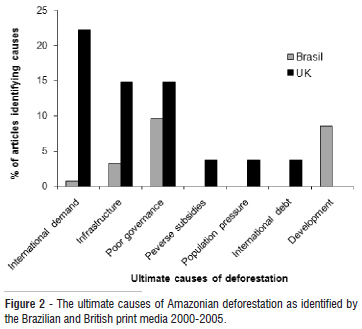The Amazon rainforest stretches across more than six million square kilometers and nine countries. Of the original forest area it is thought that 18 per cent has been cleared, mainly for farming purposes. In Brazil, the main drivers of deforestation are beef ranching and soya production that together occupy more than 75 per cent of newly deforested land. The situation in the Amazon illustrates a fundamental dilemma facing environmentalists around the world: how to reconcile economic development with biodiversity conservation. In this paper the representation of this dilemma in the British and Brazilian news media is assessed. The results indicate that there were far more articles referring to deforestation in the Brazilian press (816 Brazilian to 29 UK) but that many of these make no mention of what factors are responsible for deforestation. The patterns of representation of the proximate (direct) causes of Amazonian deforestation were very similar in the two countries, with soya and beef cattle ranching commanding the most press attention. The ultimate (indirect) causes of deforestation, however, are treated very differently, with the Brazilian media seemingly far more aware of the role of economic development needs than the UK press. Interestingly, the role of international demand for soya, beef, and forest products in driving deforestation was highlighted primarily in the UK press. These findings are critically discussed in the context of media influence on public understandings of Amazonian deforestation.
development; globalization; Amazon rainforest; newspapers



